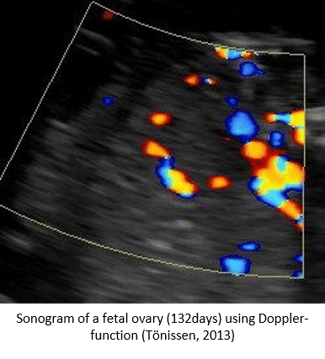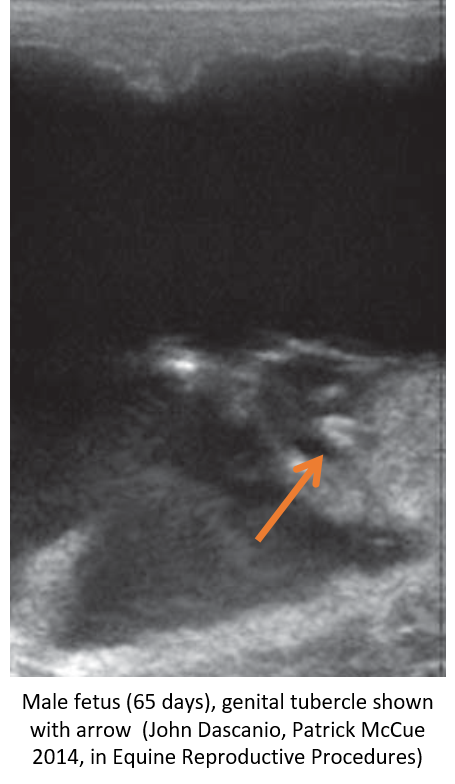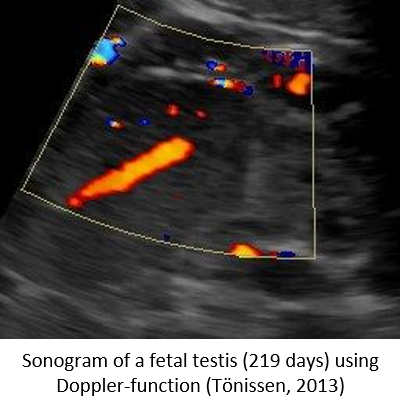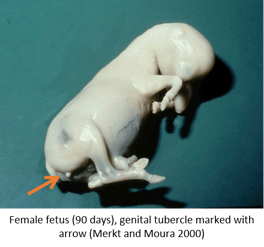 Horse breeders are always interested in the well being of their broodmares as well as the well being of the fetus they are carrying. Advances in reproductive techniques have made it possible to gain insight into how the fetus is progressing as well as the ability to determine its gender. Knowing whether a mare is carrying a colt or a filly can help owners make important decisions concerning their herds and the industry in general. For example, fetal sex determination is used on a regular basis among thoroughbred breeders prior to stock auctions. In this article, we discuss the sorting of equine sperm for sex as well as fetal sex determination via transrectal and transabdominal ultrasound.
Horse breeders are always interested in the well being of their broodmares as well as the well being of the fetus they are carrying. Advances in reproductive techniques have made it possible to gain insight into how the fetus is progressing as well as the ability to determine its gender. Knowing whether a mare is carrying a colt or a filly can help owners make important decisions concerning their herds and the industry in general. For example, fetal sex determination is used on a regular basis among thoroughbred breeders prior to stock auctions. In this article, we discuss the sorting of equine sperm for sex as well as fetal sex determination via transrectal and transabdominal ultrasound.
Sexed stallion semen
The ability to determine a foal’s gender before fertilization would seem to be the easiest way to determine whether a mare will have a colt or filly. In cattle, sexed semen is used on a daily basis. However, in the horse breeding industry there are still some difficulties to be considered with this process.
Equine semen is sorted by high speed flow cytometry based on the different amount of DNA in X and Y containing spermatozoa (between 3.4 and 3.7% more DNA in the X sperm). The success rate of sorting equine sperm is over 90%. However, the process contains several steps which result in a great amount of stress on the sperm. The sorting rates are still very low, about 25K to 30K sperm per second in which 5000 sperm are selected for sex. However, the sperm are moving at a fast rate through the flow cytometer and may not be oriented in such a way that the sex can be determined. Thus, most sperm go undetected for their sex. It is recommended that a typical cooled semen dose contain at least 500 million progressively motile sperm. However, when breeding with sexed semen, a dose typically consists of approximately 25 million motile sperm. Due to this low sperm number, insemination has to be planned and conducted in a timely manner. Also, the survival time of sexed semen is short and the sexed sperm do not survive the freezing process well. Therefore, insemination must to be performed as soon after sorting and as close to ovulation as possible.
Also, sperm sorting technology is patented and only available at a few select locations. Due to the patent, this technology cannot be used for commercial applications in Europe.
Gender Determination From 54 – 80 days Gestation
 Due to the limitations of sex sorting equine sperm, the next practical way to determine the gender of the fetus is in utero. Typically, the fetal gender can be determined by transrectal examination between 54 and 80 days of gestation. The process is based on localizing the genital tubercle (photo right and bottom left). This small structure is the precursor of the primary sexual organ of the foal, penis in male and clitoris in female, and can be identified as early as 52 days. During this stage, the distance of the tubercle between tail and umbilical cord is the same. However, just two days later the bilobulated shaped tubercle migrates forward towards the umbilical cord of a male fetus and backward towards the tail of a female fetus. Recent research shows, the period of time to perform early gender determination can be expanded and that between 48-75 days the optical features (structure, seize and position) are even more significant. After 80 days of gestation, amniotic fluid decreases and pulls the uterus over the pelvic rim, so the fetus’ abdomen is unreachable by an examiners hand.
Due to the limitations of sex sorting equine sperm, the next practical way to determine the gender of the fetus is in utero. Typically, the fetal gender can be determined by transrectal examination between 54 and 80 days of gestation. The process is based on localizing the genital tubercle (photo right and bottom left). This small structure is the precursor of the primary sexual organ of the foal, penis in male and clitoris in female, and can be identified as early as 52 days. During this stage, the distance of the tubercle between tail and umbilical cord is the same. However, just two days later the bilobulated shaped tubercle migrates forward towards the umbilical cord of a male fetus and backward towards the tail of a female fetus. Recent research shows, the period of time to perform early gender determination can be expanded and that between 48-75 days the optical features (structure, seize and position) are even more significant. After 80 days of gestation, amniotic fluid decreases and pulls the uterus over the pelvic rim, so the fetus’ abdomen is unreachable by an examiners hand.
Examination requires a veterinarian with experience in transrectal examination of mares and fetal gender determination. Knowledge of fetal anatomy and excellent technical equipment are indispensable as well.
Gender Determination After 90 Days Gestation
From 90 days of gestation until birth, fetal gender can be determined by identifying external genitalia (penis in male, mammary glands and vulva in female) and gonads (testis, ovary) with transrectal or transabdominal ultrasound.
As long as the fetus is in posterior presentation (foals head facing the same direction as the mare’s head), fetal hindquarters are reachable by a veterinarian’s hand during transrectal examination. After 140 days, reaching the fetal organs of interest by transrectal examination is almost impossible and this is when the transabdominal approach should be chosen.
 It is possible to perform fetal sexing transabdominally beginning on 90 days of gestation up to term. However, the optimal time is between 140 – 150 days of gestation. The mare’s belly should be scrubbed with alcohol, especially the back part surrounding the udder, and an ultrasound unit with a convex probe should be used for examination.
It is possible to perform fetal sexing transabdominally beginning on 90 days of gestation up to term. However, the optimal time is between 140 – 150 days of gestation. The mare’s belly should be scrubbed with alcohol, especially the back part surrounding the udder, and an ultrasound unit with a convex probe should be used for examination.
Fetal gonads are oval shaped and located in the back third of the abdomen. They can be found underneath the kidneys and above the bladder in both sexes. Due to hyperplasia of interstitial cells, they are disproportionately large and can be found easily. The appearance of male gonads during ultrasound examination is homogenous with a bright, almost white, line along the center (photo left). Whereas in female gonads, a bright circle along the outer layer (photo top left) can be seen. The main differentiating factor is the pattern of blood flow within the organ which can be visualized using the color Doppler function of the ultrasound unit. An intense central signal reflecting the white line can be seen in the male fetus or an intense circular signal can be seen in the female fetus. The fetal penis of a colt can be found behind the umbilical cord. The fetal mammary glands (triangular shaped) of the filly can be found beside the inner thigh and the clitoris underneath the tail.
Conclusion
Techniques to predict gender are established and accurate when used by experienced veterinarians. Early determination has been successfully performed for several years while determination later in gestation is relatively new, especially by transabdominal examination.
In order to get the best images of the fetus, the mare needs to be very calm and relaxed as her excitement will influence the fetus. As long as a good image is obtained the accuracy of fetal sexing can be quite high. However, fetal movements deteriorate the view and complicate the ability to determine the sex of the foal. Stocks to restrain the mare, quiet surroundings and proper lighting are recommended. If a proper examination isn’t possible during the first attempt the mare should be walked around before trying again. In some cases, sedation of the mare may be necessary.
 The transabdominal approach is the safest, least invasive and least stressful way to determine the gender of the fetus. However, determining the fetal sex at this late stage may defeat the purpose if you are trying to sell the mare in a sale. Yet, it’s a good way to examine small horses and ponies which may prove difficult to exam transrectally. One disadvantage may be the equipment required for examination and the preparation may take more time.
The transabdominal approach is the safest, least invasive and least stressful way to determine the gender of the fetus. However, determining the fetal sex at this late stage may defeat the purpose if you are trying to sell the mare in a sale. Yet, it’s a good way to examine small horses and ponies which may prove difficult to exam transrectally. One disadvantage may be the equipment required for examination and the preparation may take more time.
Gender determination can be included in the late pregnancy checkup during the fall when valuable information about fetal well-being (size, movement, heart rate, aortic diameter) and fetal-maternal well-being (combined thickness of uterus and placenta, free floating particles in amniotic fluid) can be gained as well. However, these techniques are not 100% accurate all of the time and mistakes can be made, especially the techniques used in later gestation to determine fetal sex. In the near future, we will have an article written by Dr. Phil Matthews of Peterson and Smith Equine Reproduction Center about embryo biopsy which is another way to determine the sex of an unborn foal.
_______________________________________________________________________________________________





